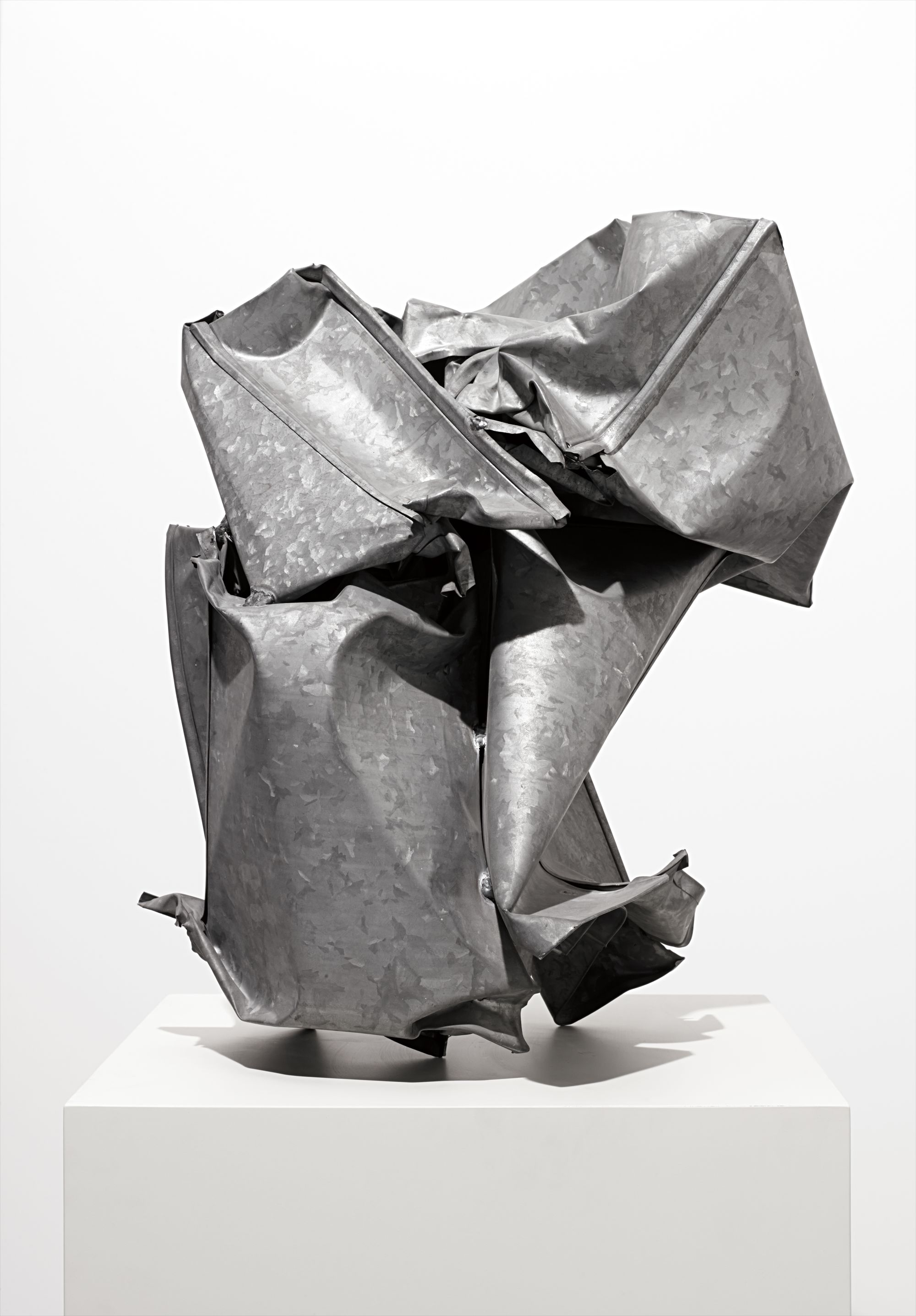



PROPERTY FROM A PRIVATE AMERICAN COLLECTION
15Ο◆
John Chamberlain
Untitled
galvanized steel
25 1/2 x 17 x 20 1/2 in. (64.8 x 43.2 x 52.1 cm)
This work has been recorded in the archives of the John Chamberlain studio.
Full-Cataloguing
“The Galvanized sculptures began with fabricated boxes; they were something like forty-two inches high, eighteen inches deep, maybe twenty-eight inches wide. They had the same proportions as the cigarette packs I'd been crushing when I sat around in bars, drinking a lot and making sculpture out of cigarette packs as we emptied them." John Chamberlain, 1980sAmerican sculptor John Chamberlain is credited with transporting Abstract Expressionism into the third dimension. A notorious figure from the moment he entered the New York art scene in the late 1950s, Chamberlain undertook a tireless pursuit of materiality and form through a distinctly intuitive process. The story of how Chamberlain created his first sculpture is legend: while staying with friend and fellow artist Larry Rivers in 1957, Chamberlain discovered an old Ford truck rusting on the property. Inspired, he tore off the fenders and proceeded to drive over them with his car to shape and form the metal pieces into the shape he wanted before fitting them together to create Shortstop. It is this idea of "fit" that continued to be a guiding principle in Chamberlain’s work. Based on the implied relationship between size and scale, fit for Chamberlain is the sculptural equivalent of collage or assemblage on a monumental scale. Throughout his career, Chamberlain insisted that the materials he worked with, most famously car parts, was out of the abundance of availability and the cheapness at which they could be acquired. However, despite the convenience of these materials, each piece of "junk" was carefully chosen by Chamberlain via a process of active selection. By recontextualizing these materials as art, Chamberlain gave them new meaning. However, he continuously rejected any metaphorical connotations that could be derived from automobile associations; he maintained they were strictly an extension of Expressionism. Often using brightly colored sections of cars this readymade material, as it were, allowed Chamberlain to challenge traditional sculptural, as well as painterly, boundaries and essentially fuse, or rather fit, them together. Chamberlain has been associated with Expressionism, Pop Art and Minimalism; however, throughout his lifetime he upheld his position firmly as an abstract artist. While his fluid forms appear to be created through incident, Chamberlains works are the outcome of a combination of intellect and intent and retain a sense of control which is evident in the thoughtfully welded elements that transform each work into a highly sophisticated collage-like composition. Chamberlain’s crowning artistic achievement was the ease through which he appeared to deform hard metal as if it were merely crumpled paper. Each of Chamberlain’s works convey elegance and emotion. They are not about the magnitude or might of the material but about the balanced scale and volume that creates their spatial mass. The present lot is an example of a rare series of sculptures made of galvanized steel that were only produced between 1967 and 1969. Weary of the criticism that was plaguing his signature car part works that situated them as a commentary on American car culture, consumerism and taste, Chamberlain sought out other materials through which he could create sculptures so as to avoid then so called "car crash syndrome." Galvanized steel, an industrialized metal that has been processed with a protective coat of zinc to prevent rusting, provided a history-less material absent of narrative. It is these works that most strongly connect Chamberlain to Minimalism, and although he embraced the austere material – a favorite of his close friend Donald Judd – these works retain the fluidity and sensuality of expressionism. Chamberlain’s galvanized steel works are the result of a process through which the artist crushed large steel boxes in a compressor. The idea behind these works was to crush the metal boxes in a process that would convey the same ease through which a cigarette carton could be crushed by hand, creating a natural form that was strictly the result of an action. Chamberlain insisted "whatever came out was what came out" and while they were not premeditated, the sculptural forms were a direct result of the actions that shaped them and represent a visual record of metamorphosis. An additional factor that contributes to the sense of sincere transformation in these works is that many of the boxes were originally created for Judd but had been slightly damaged and therefore did not fit with his structured aesthetic. By reclaiming and resituating these boxes, Chamberlain gave new life to a material that would have otherwise been discarded, in a similar vein as he did with the car parts.More than any other of his works, the galvanized steel pieces play with visual judgments of weight. These sculptures were created from fairly light sheets of metal and formed into hollow cubes. Once crushed, the volume and density increased as the metal folded onto itself, concentrating the energy rather than dispersing it. The simplicity of Chamberlain’s practice is thus the complex underpinnings that allowed him to endow an ascetic material with a highly emotional value. The sensuality of the folds transforms the hard lifeless metal into a work comprised of natural soft forms full of movement. Although he considered himself a colorist, these monochromatic works are a coherent extension of his practice because Chamberlain believed the galvanized pieces had "their own color." Above all, Chamberlain respected the inherent properties of the materials he used and embraced the absorbent, non-reflective surface of galvanized steel.